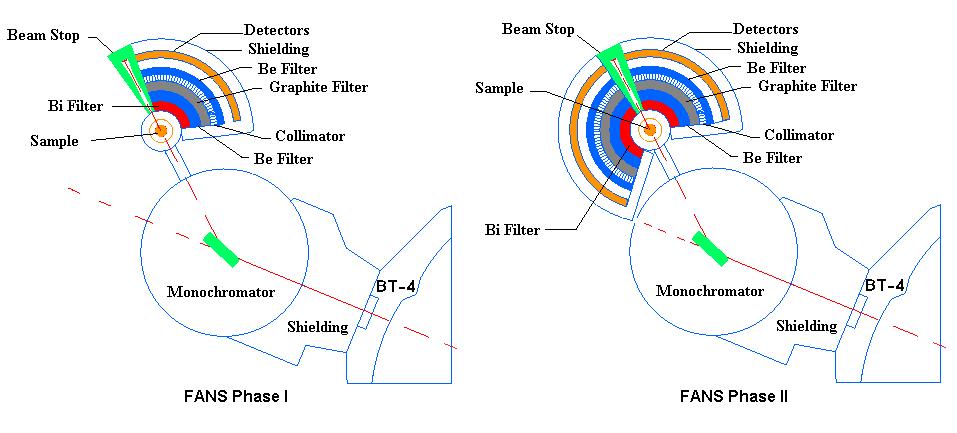
|

|
|
| Home | FANS-HOME | Instruments | Contacts | SiteMap |
FILTER-ANALYZER NEUTRON SPECTROMETER (FANS)
The Filter Analyzer Neutron Spectrometer is the instrument used for neutron vibrational spectroscopy installed at the NCNR. It is design to reveal fine details of the vibrational motion of molecules acting as “fingerprints” of their surroundings in materials. This instrument offers a choice for monochromators, a combination of polycrystalline Be followed by a block of polycrystalline graphite analyzer cooled to 77 K, and a Bi filter that makes it the most versatile of the thermal-neutron scattering instruments at NIST.
FANS - Principle of the technique
The operation of FANS is simple: Monochromatic neutrons of variable energy are inelastically scattered from the sample and detected at a fixed final energy Ef after they pass through a low-pass Bragg cutoff filter (polycrystalline beryllium and graphite, giving a cutoff of ~1.8 meV [see figure below]). Inelastic spectra are recorded by scanning the incident energy and detecting all scattered neutrons with energy Ef < Ecutoff. The filter-detector assembly of FANS consists of two wedges spanning 230 degrees (phase I, which has been completed, uses only the smaller ~110 degree wedge). In phase II, double focusing monochromators will be used to increase the neutron intensity for all incident energies.
An instrument upgrade in two phases is underway which includes new Cu(311) and Ge(311) double-focusing monochromators (to replace the vertically focusing Cu(220) and PG(002) ones), and a detector coverage of 9% of 4p steradians.
For phase I, the monochromator choices are (i) Cu (220) for higher resolution studies, or for measurements with higher incident neutron energies, and (ii) pyrolytic graphite (002) for lower incident energies, with moderate resolution and higher beam intensities. Monochromator changes can be made within a few minutes from the instrument console. Both monochromators are vertically focusing with a radius of curvature which changes to optimize intensity during the course of data acquisition.
The enhanced sensitivity of the new FANS allowed us to determine the origin of the spurious background scattering features between 50 and 85 meV. As a result, a Bi filter is being built, which essentially eliminates spurious Be phonons in the critical 50 - 85 meV region, replacing them with Bi phonons only at 12 meV and below. This greatly enhances the capability of FANS for probing smaller, more dilute, and more weakly scattering systems.

And in phase II, the monochromator choices will be Cu(311)/Ge(311) double-focusing monochromators, and the filter-detector assembly will consist of two wedges spanning the total of 230 degrees. Thus, a high neutron intensity for all incident energies will be maintained, and neutrons scattered by the sample will be detected in a much larger solid angle.
| Craig M. Brown | (301) 975 5134 | |
| Terry Udovic | (301) 975 6241 | |
| Juscelino Leão | (301) 975 8867 |